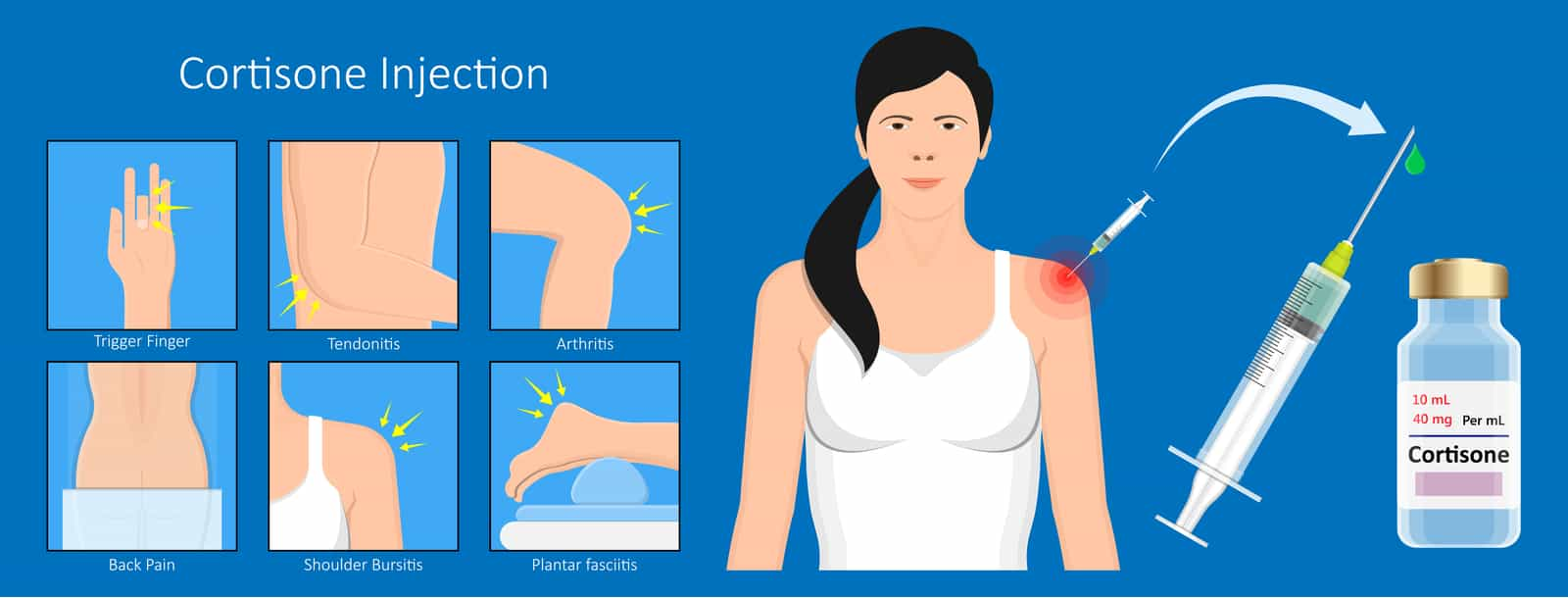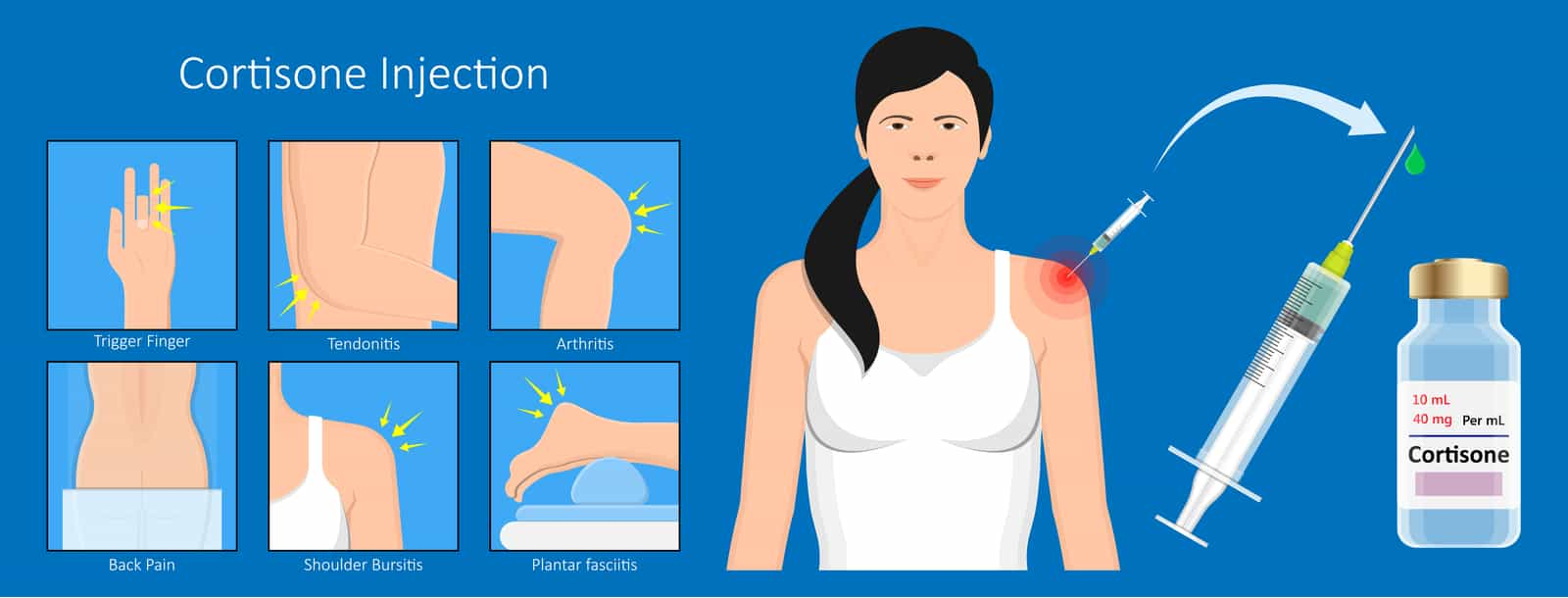Cortisone Injections vs Viscosupplementation: Indications, Benefits, Usage, and Risk Factors
March 17th, 2021 | 6 min. read

Regardless of diagnosis, treatment and control of pain associated with the problem, is an important part of medical care. In fact, it is often the most pressing issue for a patient. Fortunately, Coastal Orthopedics on the Texas Gulf Coast provides treatment options for patients with arthritis, including knee arthritis, bursitis, trigger finger, and many other inflammatory disorders. Two treatment considerations for many orthopedic conditions are cortisone injections and viscosupplementation.
What Is a Cortisone Injection?
Cortisone is a certain type of steroid made naturally by your adrenal glands. These glands are found above each of your kidneys. There are multiple medical formulations of corticosteroids, which can be used in oral pill form, or injection form.
Cortisone reduces inflammation, and therefore can reduce pain. Injection treatments can last anywhere from several days to over six months. They can even definitively treat, or resolve some problems permanently or semi-permanently. Diagnoses like arthritis, tendonitis, bursitis, trigger finger, etc, are inflammatory conditions. Your physician may recommend treatment with a steroid injection if you have failed more conservative options with NSAID or other medications, PT, rest, ice/heat, or bracing.
If you’re experiencing moderate-to-severe pain, you may be a good candidate for corticosteroids.
Although cortisone injections don't produce the same types of side effects as oral steroids do, they still come with risks of their own. For this reason, steroid treatments should be used judiciously, and your physician is likely to place a limit on how many injections you can receive — likely no more than four in a year.
Indications for Cortisone Injections
Many ailments where inflammation is the underlying issue are treatable with cortisone shots. For example:
- Arthritis. Osteoarthritis results in wear and tear that causes joint inflammation and degeneration. It is most common in the weight-bearing joints like the hips and knees, but can also occur in the shoulders or other smaller joints. Autoimmune arthritis can also be treated with steroid injection.
- Shoulder bursitis. Impingement and inflammation in the bursa and soft tissues around the shoulder is very common and can also be treated with injection.
- Trigger finger. Trigger finger is an inflammatory condition effecting the soft tissues of the hand. You may have painful 'triggering' or catching with range of motion, or the fingers may even get stuck in the flexed position. Sometimes steroid injection can treat the inflammation and improve or resolve the problem.
- Plantar fasciitis. This condition of the foot can be quite painful, particularly in the morning when you first get out of bed. Steroid injection can be used in moderate-severe cases when the pain does not improve with shoe inserts, or physical therapy.
This is not an exhaustive list, and there are other ailments and conditions, such as golfers elbow, tennis elbow, carpal tunnel syndrome, and biceps tendonitis, to name a few, that cortisone injections may be beneficial for.
Interested in cortisone or viscosupplemtation injections in Corpus Christi?
Click the image below to schedule an appointment with one our clinicians to see if an injection is right for you!
Benefits of Cortisone Injections
Benefits include:
- Increased function and reduced pain.
- Decreased joint inflammation while preserving your joint function and structure.
- Tolerance for local cortisone injections and decreased likelihood of experiencing severe side effects than other types of steroid medicines.
- Potential avoidance of increased doses of oral steroids or having to take oral steroids altogether, which can have greater side effects.
- In-office procedure
Risks of Cortisone Injections
Some risks of cortisone injections are:
- Skin discoloration. Steroid can cause depigmentation, or lightening of the skin around the injection site. This can occur several weeks or months after you receive the injection.
- Cortisone flare. Injected cortisone medicine could crystallize inside your body, causing inflammation and pain that's worse than the inflammation and pain due to the condition being treated. This is called cortisone flare. Flares usually last one or two days and are treatable with intermittent cold packs and rest.
- Elevated blood sugar. Steroid treatment can temporarily elevate your blood sugar. Individuals with diabetes should let their doctor know before they receive an injection and have their blood sugar levels closely monitored for a couple of days after their cortisone injection. This is particularly important for diabetic patients with fragile or poorly controlled diabetes.
- Fat atrophy. A cortisone injection might lead to fat cells at the injection area to atrophy. A depression or divot in your skin might appear due to the underlying fat cells deteriorating. Your skin's appearance typically will go back to normal in six months, but it could take two or three years.
- Infection. While it's rare, infection is a severe possible side effect of any invasive treatment. Individuals who are more susceptible to infection, like those taking immune-suppressing medication or those with an autoimmune disease should let their doctor know. After being given a cortisone injection, any person who runs a fever or suspects an infection is advised to speak with their physician.
- Joint and/or nerve damage. If you receive too many injections, your cartilage could break down, leading to joint and/or nerve damage.
- Allergic reaction. Individuals should inform their physician if they have ever experienced an allergic reaction after an injection. While this isn't that common, certain individuals have allergic reactions to the added local anesthetic in the injection (typically lidocaine). An allergic reaction to cortisone itself is rare since cortisone is a cortisol synthetic version and this is a steroid found naturally in your body.
- Facial flushing. Flushing may occur temporarily
- Insomnia.
- Weakening or rupture of tendons. Cortisone injection administered directly into a tendon has been reported to weaken and damage the collagen fibers thus carrying a risk of delayed rupture. For this reason, cortisone is only injected around the tissue surrounding a tendon and the tendon is rested for one week.
What Is Viscosupplementation?
The bones that make up your joints have a cap of cartilage on their ends to allow for smooth range of motion. This cartilage has a fluid coating that contains hyaluronic acid. This works like a lubricant and shock absorber in your joint.
In osteoarthritis (“wear-and-tear” arthritis), this cartilage cap wears thin and breaks down. People with osteoarthritis generally have less hyaluronic acid in their joints than they should, which may result in pain and swelling. The idea behind viscosupplementation is that replacing or supplementing this hyaluronic acid may help reduce these symptoms. This treatment is most effective for patients with mild-moderate degeneration of the joint.
Viscosupplement treatment most often does not result in immediate pain relief. You might even experience a little pain, swelling, and a warm feeling at the injection site. It helps to apply an ice pack, or use NSAID's, and you should notice your symptoms improving quickly. You'll want to plan to rest and only do light activities for about 48 hours after your treatment.
You'll likely find your pain begins to lessen as you complete the series of injections. While hyaluronic acid isn't an anti-inflammatory, it might stimulate your body to produce more of its own natural hyaluronic acid. Those with early, mild-to-moderate knee problems seem to benefit most. Viscosupplementation isn't suggested for individuals who have severe, end-stage, or bone-on-bone arthritis.
Indications for Viscosupplementation
The primary indication for viscosupplementation is to treat mild-to-moderate osteoarthritis. But injections of hyaluronic acid might also be indicated in individuals with:
- Intolerance or contraindications to nonsteroidal anti-inflammatory drugs (NSAIDS)
- Patients who are poor surgical candidates
- Chondrocalcinosis
- Any type of cartilage injury
- Clinical evidence shows support for using intra-articular hyaluronic acid in individuals intolerant to NSAIDS and those wishing to defer or not willing to undergo surgery.
Benefits of Viscosupplementation
There are various benefits of viscosupplementation, which include:
- Reducing discomfort and swelling in the effected joint
- Improving quality of life and ability to participate in activities of daily living
Risk Factors of Viscosupplementation
Commonly reported side effects linked with viscosupplementation are:
- Swelling
- Temporary injection-area pain
- Bruising around the joint
- Redness, heat, itching, and rash
- Fluid accumulation in the injected knee
- Developing gout
Reactions like these are typically mild and don't last very long.
The most serious risks are bleeding and infection. Viscosupplementation is contraindicated in individuals with hypersensitivity (allergies) to sodium hyaluronate preparations and those with known skin diseases or infections around and in the injection area.
There’s also a risk that viscosupplementation won’t help your specific condition.
Main Differences Between Cortisone Injections and Viscosupplementation
Both types of treatment inject a fluid into the body area affected by arthritis to help decrease the inflammation in the joints as a way of imparting pain relief. But, this is where the similarities end.
Cortisone shots are more generalized treatments than viscosupplementation since they merely treat the arthritis symptoms (inflammation). However, viscosupplementation addresses the root causes directly by supplementing your joint with the hyaluronic acid cushioning fluid to make up for lost cartilage. It can also help to increase joint function and motion in arthritic knees, which genuinely improves your overall life quality.
Furthermore, viscosupplementation usually lasts longer than cortisone shots too (six months rather than several weeks or months like steroid injections).
Both arthritis treatments have helped individuals for years. When there's no cure for your disease, you want whatever type of pain relief you can get. But, before subjecting your body to just any type of injection promising the help you feel better, you'll always want to speak with your doctor first to determine which treatment is right for treating your condition.
Takeaway
If you're not experiencing the pain relief you need and deserve with oral medicines for arthritic pain or inflammation, your physician might suggest joint injections. And, these two primary types again are viscosupplementation and cortisone injections. Cortisone injections are recommended for individuals with moderate-to-severe pain, while viscosupplementation is recommended for individuals with mild-to-moderate osteoarthritis.
Both come with their own set of risks and side effects as well as benefits. Consult with your Coastal Orthopedics doctor to come up with the right treatment plan for your own personal situation and what will work best for you.
Dr. Williams has been practicing orthopedic surgery in Corpus Christi since 1998. After graduating from Texas Tech hereceived his medical degree from the University of Texas at San Antonio. At the prestigious Campbell Clinic located at the University of Tennessee, Dr. Williams completed not only an Orthopedic Surgery Residency, but an additional year of Fellowship Training in Spine Surgery. Dr. Williams is dedicated to creating an excellent patient experience in the office or in the surgery suite.



